technical data AUDI S3 2010 Owner's Guide
[x] Cancel search | Manufacturer: AUDI, Model Year: 2010, Model line: S3, Model: AUDI S3 2010Pages: 320, PDF Size: 75.34 MB
Page 187 of 320

_______________________________________________ C_h _ i_ld _ S_ a_ f_ e_ t..,:c y __ _
-Guide the upper tether strap under the rear head
restraint and into the rear cargo area==> fig. 157 (raise the
head restraint if necessary).
- Slide the tether strap hook over the anchor bracket.
- Pull on the tether strap hook so that the spring catch of
the hook engages .
- Tighten the tether strap firmly following the child
restraint manufacturer's instructions.
Releasing the tether strap
- Loosen the tension following the child restraint manufac
turer's inst ructions.
- Depress the spring catch on the hook and release it from
the anchorage.
0 Note
If you leave the child restraint with the tether strap firmly installed
for several days, this could leave a mark on the upholstery on the
seat cushion and backrest in the area where the tether strap was
installed. The upholstery would also be permanently stretched
around the tether strap. This applies especially to leather seats. •
Using tether straps on rearward-facing child
restraints
Currently, few rear-facing child restraint systems come with a tether.
P lease read and heed the child restraint system manufacturer's
instructions carefully to determine how to properly install the
tether.
Controls and equip ment Safety first Vehicle operation
& WARNING
A
child in a rearward-facing child safety seat installed on the front
passenger seat will be seriously injured and can be killed if the
front airbag inflates -even with an Advanced Airbag System .
• The inflating airbag will hit the child safety seat or infant
carrier with great force and will smash the child safety seat and
child against the backrest, center armrest, or door.
• A tight tether or other strap on a rearward-facing child restraint
attached to the front passenger seat can put too much pressure
on the weight-mat in the seat and register a heavier weight in the
Advanced Airbag System. The heavier weight registered can make
the system work as though an adult were on the seat and deploy
the Advanced Airbag when it must be suppressed causing serious
or even fatal injury to the child.
• If you must install a rearward facing child safety seat on the
front passenger seat because of exceptional circumstances and
the PASSENGER AIR BAG OFF light does not come on and stay on,
immediately install the rear -facing child safety seat in a rear
seating position and have the airbag system inspected by your
Audi dealer. •
Additional Information
Sources of information about child restraints
and their use
There are a number of sources of additional information about child
restraint selection, installation and use:
NHTSA advises that the best child safety seat is the one that fits
your child and fits in your vehicle, and that you will use correctly and
consistently.
Try before you buy!
Vehicle care Do-it-yourself service Technical data
Page 189 of 320

_____________________________________________ C_ h _ il_d _S_ a _ fe_t---= y'---_JII
Controls and equip
ment Safety first
Vehicle operation Vehicle care Do-it-yourself service Technical data
Page 191 of 320
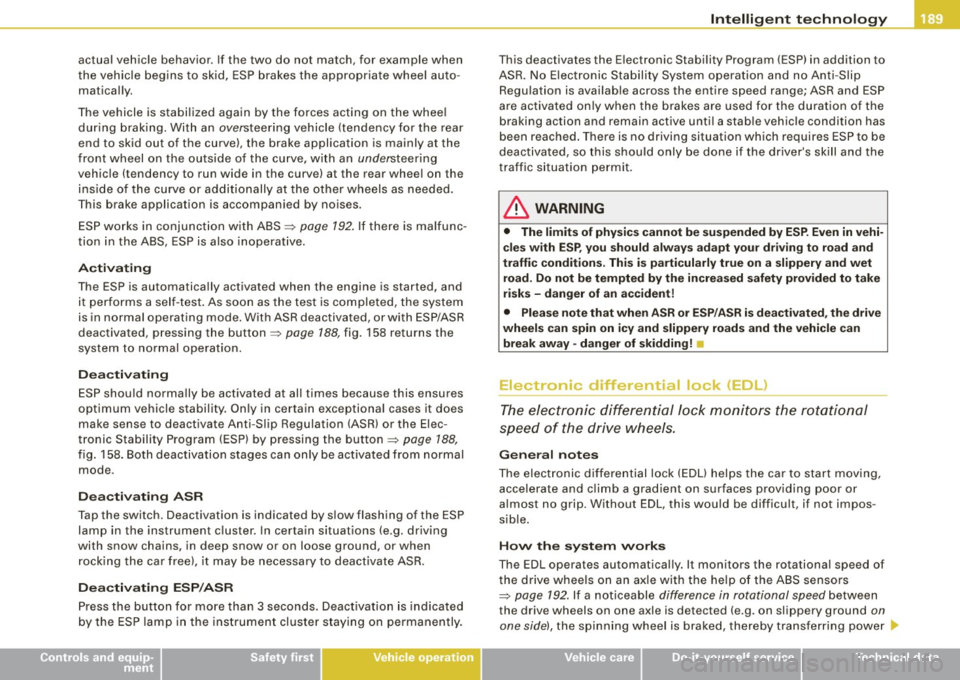
actual vehicle behavior. If the two do not match, for example when
th e vehicle begins to skid, ESP brakes the appropriate wheel auto
matical ly .
The vehicle is stabilized again by the forces acting on the wheel
during braking. With an oversteering vehicle (tendency for the rear
end to skid out of the curve), the brake application is mainly at the
front wheel on the outside of the curve, with an
understeering
vehicle (tendency to run wide in the curve) at the rear wheel on the
inside of the curve or additionally at the other wheels as needed.
This brake application is accompanied by noises.
ESP works in conjunction with ABS=>
page 192. If there is malfunc
tion in the ABS, ESP is also inoperative.
Activating
The ESP is automatica lly activated when the engine is started, and
it performs a self-test. As soon as the test is completed, the system
is in normal operating mode. With ASR deactivated, or with ESP/ASR
deactivated, pressing the button=>
page 188, fig. 158 returns the
system to normal operation.
Deactivating
ESP should normally be activated at all times because this ensures
optimum vehicle stability. Only in certain exceptional cases it does
make sense to deactivate Anti-Slip Regulation (ASR) or the Elec
tronic Stability Program (ESP) by pressing the button =>
page 188,
fig. 158. Both deactivation stages can only be activated from normal
mode .
Deactivating ASR
Tap the switch. Deactivation is indicated by slow flashing of the ESP
lamp in the instrument cluster. In certain situations (e .g. driving
with snow chains, in deep snow or on loose ground, or when
rocking the car free), it may be necessary to deactivate ASR.
Deactivating ESP/ASR
Press the button for more than 3 seconds. Deactivation is indicated
by the ESP lamp in the ins trument cluster staying on permanently.
Controls and equip
ment Safety first Vehicle operation
Intelligent technology
This
deactivates the Electronic Stability Program (ESP) in addition to
ASR. No Elec tronic Stability System operation and no Anti -Slip
Regulation is available across the entire speed range; ASR and ESP
are activated only when the brakes are used for the duration of the
braking action and remain active until a stable vehicle condition has
been reached. There is no driving situation which requires ESP to be
deactivated, so this should only be done if the driver's skill and the
traffic situation permit.
& WARNING
• The limits of physics cannot be suspended by ESP. Even in vehi
cles with ESP. you should always adapt your driving to road and
traffic conditions. This is particularly true on a slippery and wet
road . Do not be tempted by the increased safety provided to take
risks -danger of an accident!
• Please note that when ASR or ESP /ASR is deactivated , the drive
wheels can spin on icy and slippery roads and the vehicle can
break away -danger of skidding!
Electronic differential lock CED1
.)
The electronic differential lock monitors the rotational
speed of the drive wheels.
General notes
The elect ronic differential lock (EDU helps the car to start moving,
accelerate and c limb a gradient on surfaces providing poor or
a lmost no grip. Without EDL, this would be difficult, if not impos
s ible.
How the system works
The EDL operates automatical ly. It monitors the rotationa l speed of
the drive wheels on an axle with the help of the ABS sensors
=>
page 192. If a noticeable difference in rotational speed between
the drive wheels on one axle is detected (e.g. on slippery ground
on
one side),
the spinning wheel is braked, thereby transferring power
Vehicle care Do-it-yourself service Technical data
Page 193 of 320
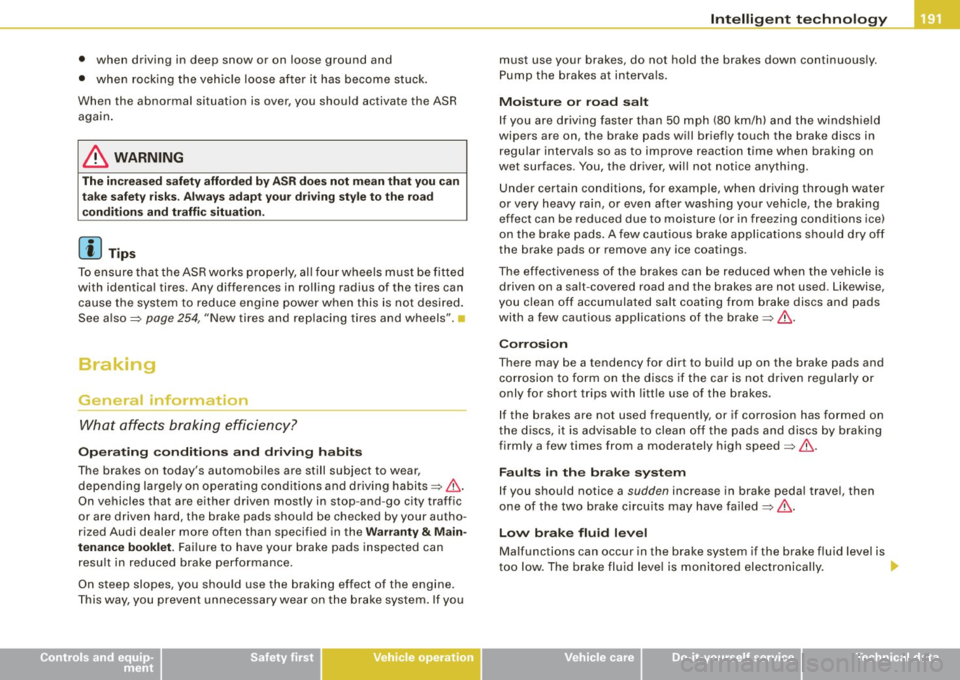
• when driving in deep snow or on loose ground and
• when rocking the vehicle loose after it has become stuck.
When the abnormal situation is over, you should activate the ASR again.
& WARNING
The increased safety afforded by ASR does not mean that you can
take safety risks. Always adapt your driving style to the road
conditions and traffic situation.
[ i J Tips
To ensure that the ASR works properly, all four wheels must be fitted
with identical tires. Any differences in rolling radius of the tires can
cause the system to reduce engine power when this is not desired.
See also~
page 254, "New tires and replacing tires and wheels". •
Braking
Generat information
What affects braking efficiency?
Operating conditions and driving habits
The brakes on today's automobiles are still subject to wear,
depending largely on operating conditions and driving habits~& .
On vehicles that are either driven mostly in stop-and-go city traffic
or are driven hard, the brake pads should be checked by your autho
rized Audi dealer more often than specified in the
Warranty & Main
tenance booklet.
Failure to have your brake pads inspected can
result in reduced brake performance.
On steep slopes, you should use the braking effect of the engine.
This way, you prevent unnecessary wear on the brake system. If you
Controls and equip
ment Safety first Vehicle operation
Intelligent technology
must use your brakes, do not hold the brakes down continuously.
Pump the
brakes at intervals.
Moisture or road salt
If you are driving faster than 50 mph (80 km/h) and the windshield
wipers are on, the brake pads will briefly touch the brake discs in
regular intervals so as to improve reaction time when braking on
wet surfaces. You, the driver, will not notice anything .
Under certain conditions, for example, when driving through water
or very heavy rain, or even after washing your vehicle, the braking
effect can be reduced due to moisture (or in freezing conditions ice)
on the brake pads. A few cautious brake applications should dry off
the brake pads or remove any ice coatings .
The effectiveness of the brakes can be reduced when the vehicle is
driven on a salt-covered road and the brakes are not used . Likewise,
you clean off accumulated salt coating from brake discs and pads
with a few cautious applications of the brake~&.
Corrosion
There may be a tendency for dirt to build up on the brake pads and
corrosion to form on the discs if the car is not driven regularly or
only for short trips with little use of the brakes.
If the brakes are not used frequently, or if corrosion has formed on
the discs, it is advisable to clean off the pads and discs by braking
firmly a few times from a moderately high speed~& .
Faults in the brake system
If you should notice a sudden increase in brake pedal travel, then
one of the two brake circuits may have failed~ &.
Low brake fluid level
Malfunctions can occur in the brake system if the brake fluid level is
too low. The brake fluid level is monitored electronically.
Vehicle care Do-it-yourself service Technical data
Page 195 of 320
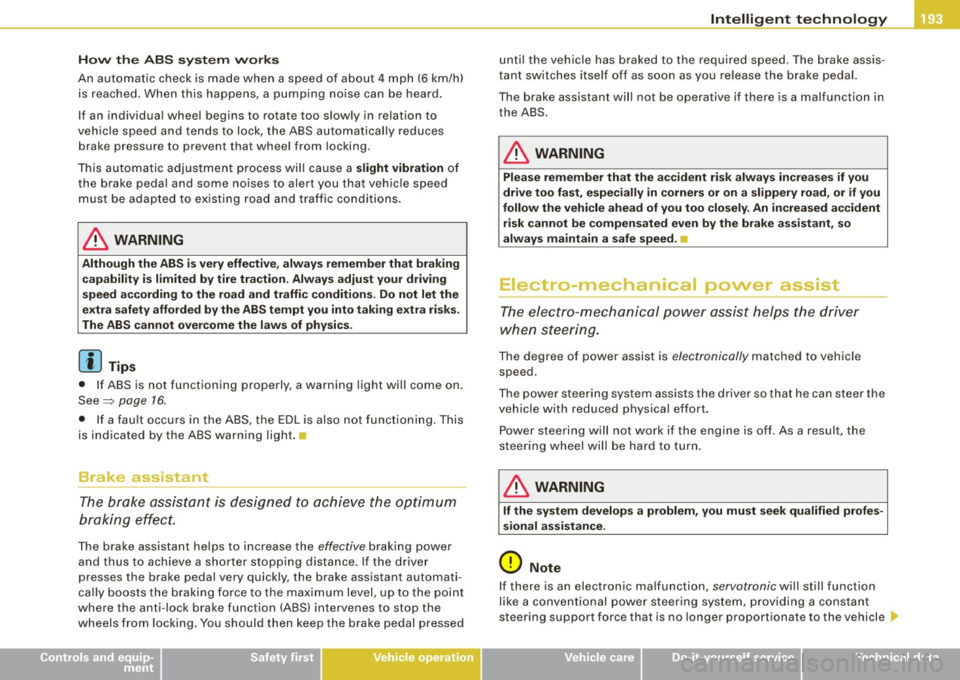
How the ABS system works
An aut omatic check is made whe n a speed of ab out 4 mph (6 km/h)
is reached. When this happens, a pumping noise can be heard.
I f an individua l wheel begins to rotate too slowly in relation to
ve hicle speed and ten ds to lock, the A BS automatical ly reduces
brake pressure to prevent that wheel from locking.
T his auto matic adjust ment p rocess wil l cause a
slight vibration o f
the brake peda l and some noises to alert you that veh ic le speed
must be ada pted to e xisting roa d and traff ic c onditions.
& WARNING
Although the ABS is very effective , always remember that braking
c apability is limited by tire tra ction . Always adjust your driving
speed according to the road and traffic conditions. Do not let the
extra safety afforded by the ABS tempt you into taking e xtra risks .
The ABS cannot overcome the laws of physics.
[ i ) Tips
• I f ABS is not functioning properly, a warning light wil l come on.
See
=> page 16.
• I f a fau lt occurs in the ABS, the E DL is als o not fu ncti onin g. This
is indicated by the ABS warning light. •
Brake assistant
The brake a ssi st ant is de sig ned to a chieve th e opti mum
b ra kin g eff ec t.
The brake assistant helps to increase the effective braking power
and thus to ac hieve a s horte r stop ping dis tance. If the drive r
presses the brake pedal very quick ly, the brake assistant automati
ca lly b oosts the braki ng force to the maximu m level, up to th e point
where the anti -loc k brake function (A BS) intervenes to stop the
whee ls from loc king. You should then keep the brake pedal pressed
Controls and equip
ment Safety first Vehicle operation
Intelligent technology
until
the vehicle has braked to the required speed . The brake assis
t an t swi tc h es itse lf o ff as s oon as you r eleas e the b rake pe dal.
The brake assistant wi ll not be operative if there is a malfunction in
the ABS .
& WARNING
Please remember that the accident risk always increases if you
drive too fast , espe cially in corners or on a slippery road , or if you
follow the vehicle ahead of you too closely . An increased accident
risk cannot be compensated even by the brake assistant , so
always maintain a safe speed. •
ciectro-mechanical power assist
Th e e le ctr o-me ch anic al pow er assis t helps the driv e r
w hen steerin g.
The degree of powe r ass ist is electronically matched to veh icle
speed .
The power steering system assists the driver so that he can steer the
ve hicle with re d uced p hysi ca l eff ort.
Power steering w ill not work if the eng ine is off . As a result, the
stee ring whee l wi ll be ha rd to turn .
& WARNING
If the system develops a problem , you must seek qualified profe s
sional assistance .
0 Note
If there is an electronic ma lfunction, servotronic will still function
like a conventi onal power s teer ing sy stem , pr ovi din g a constant
steerin g support force that is no longer proportionate to the vehicle
Vehicle care Do-it-yourself service Technical data
Page 197 of 320
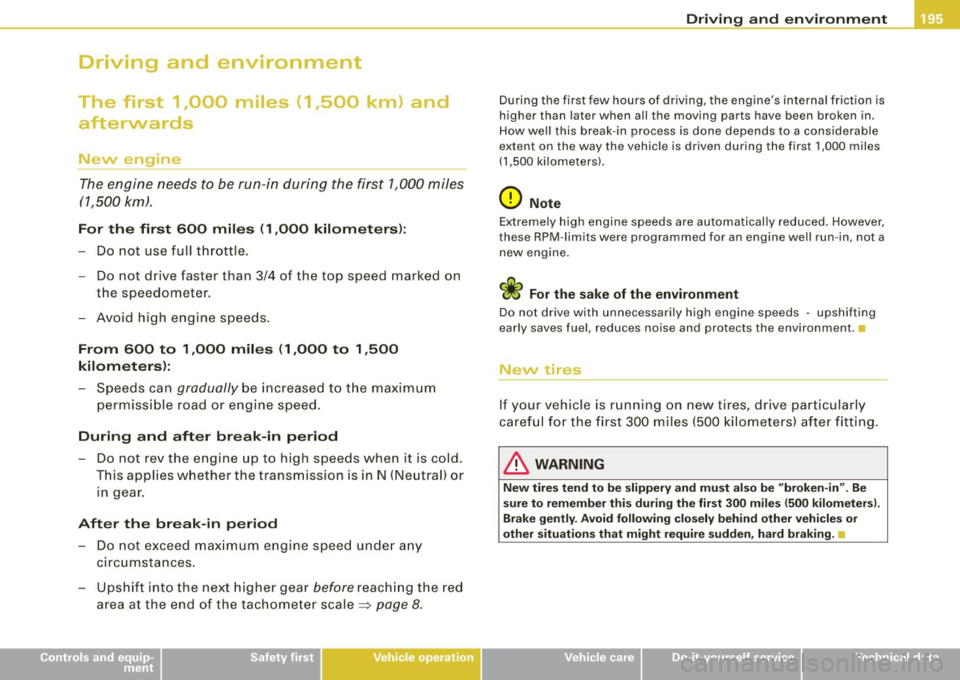
Driving and environment
The first 1,000 miles (1,500 km) and afterwards
!\Jew engine
The engine needs to be run-in during the first 1,000 miles
(1,500 km).
F o r th e fir st 600 mil es (1,000 kilomet ers):
Do not use full throttle.
- Do not drive faster than 3/4 of the top speed marked on
the speedometer.
- Avoid high engine speeds .
From 600 t o 1,000 mil es (1,000 t o 1,500
kil om eter s):
- Speeds can gradually be increased to t he maximum
permiss ible road or engine speed .
During and aft er br eak-in p eri od
- Do not rev the engine up to high speeds when it is cold. This applies whether the transm ission is in N (Neutral) or
1n gear.
Aft er the br eak-in p eriod
- D o not exceed max imum e ngine speed unde r any
circumstances.
- Upshift into the next higher gear before reaching the red
area at the end of the tachome ter scale
~ page 8 .
Controls and equip
ment Safety first Vehicle operation
Dri
ving and environm ent
During the first few hours of driving, the eng ine's internal friction is
higher than later when all the moving parts have been broken in.
How well this break -in process is done depends to a considerable
extent on the way the vehicle is driven during the first 1,000 miles
(1,500 ki lometers).
0 Not e
Extreme ly high engine speeds are automatically reduced. However,
these RPM -limits were programmed for an engine we ll run-in, not a
new engine .
~ For the sake of the environment
Do not drive with unnecessarily high engine speeds -upshifting
early saves fuel, reduces noise and protects the environment .
New tires
If your v ehic le is running on new tires, driv e particularly
carefu l for the first 300 miles (500 ki lometers) after fitting.
& WARNING
N ew tir es tend to be slipp ery and mu st al so be "brok en -in ". B e
su re to r ememb er thi s during th e fir st 300 m ile s ( 50 0 k ilome te rs).
Brak e gen tly. Av oid follow ing close ly behind other vehicl es or
o the r s ituati ons that mig ht requi re su dde n, ha rd b raking.•
Vehicle care Do-it-yourself service Technical data
Page 199 of 320
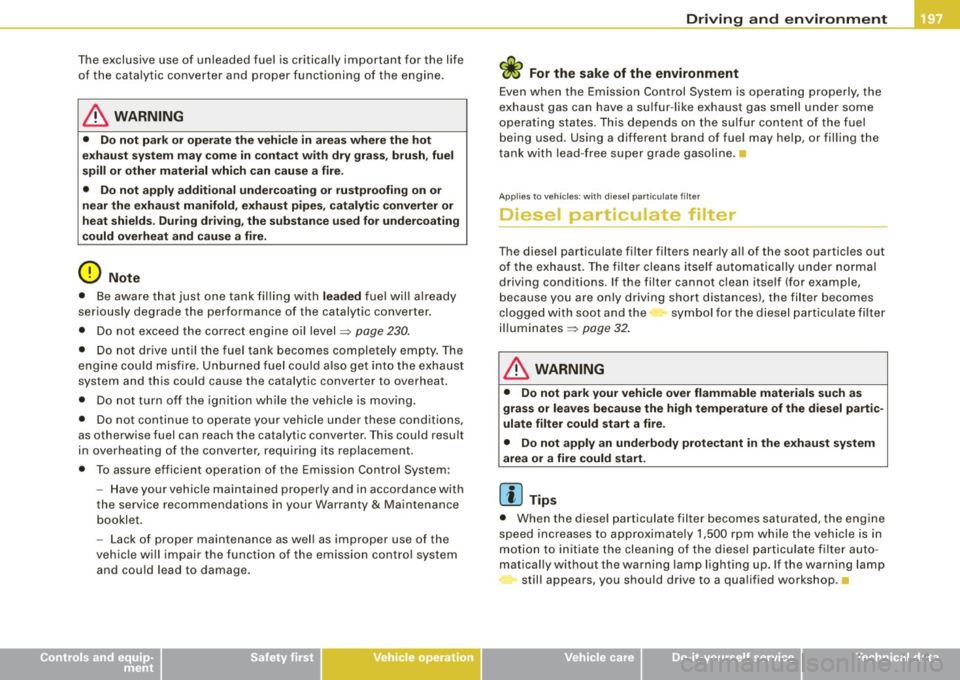
The exclusive use of unleaded fuel is critically important for the life
of the catalytic converter and proper functioning of the engine.
& WARNING
• Do not park or operate the vehicle in areas where the hot
exhaust system may come in contact with dry grass, brush, fuel
spill or other material which can cause a fire.
• Do not apply additional undercoating or rustproofing on or
near the exhaust manifold, exhaust pipes, catalytic converter or
heat shields . During driving, the substance used for undercoating
could overheat and cause a fire.
0 Note
• Be aware that just one tank filling with leaded fuel will already
seriously degrade the performance of the catalytic converter.
• Do not exceed the correct engine oil level~
page 230.
• Do not drive until the fuel tank becomes completely empty. The
engine could misfire. Unburned fuel could also get into the exhaust
system and this could cause the catalytic converter to overheat.
• Do not turn off the ignition while the vehicle is moving.
• Do not continue to operate your vehicle under these conditions,
as otherwise fuel can reach the catalytic converter. This could result
in overheating of the converter, requiring its replacement.
• To assure efficient operation of the Emission Control System :
- Have your vehicle maintained properly and in accordance with
the service recommendations in your Warranty
& Maintenance
booklet.
- Lack of proper maintenance as well as improper use of the
vehicle will impair the function of the emission control system
and could lead to damage.
Controls and equip ment Safety first Vehicle operation
Driving and environment
<£' For the sake of the environment
Even
when the Emission Control System is operating properly, the
exhaust gas can have a sulfur -like exhaust gas smell under some
operating states . This depends on the sulfur content of the fuel
being used . Using a different brand of fuel may help, or filling the
tank with lead-free super grade gasoline. •
Applies to veh ic les : with diesel particulate filter
Diesel particu ate filter
The diesel particulate filter filters nearly all of the soot particles out
of the exhaust. The filter cleans itself automatically under normal
driving conditions. If the filter cannot clean itself (for example,
because you are only driving short distances), the filter becomes
clogged with soot and the symbol for the diesel particulate filter
illuminates ~
page 32.
& WARNING
• Do not park your vehicle over flammable materials such as
grass or leaves because the high temperature of the diesel partic
ulate filter could start a fire.
• Do not apply an underbody protectant in the exhaust system
area or a fire could start.
[ i] Tips
• When the diesel particulate filter becomes saturated, the engine
speed increases to approximately 1,500 rpm while the vehicle is in
motion to initiate the cleaning of the diesel particulate filter auto
matically without the warning lamp lighting up. If the warning lamp
still appears, you should drive to a qualified workshop. •
Vehicle care Do-it-yourself service Technical data
Page 201 of 320
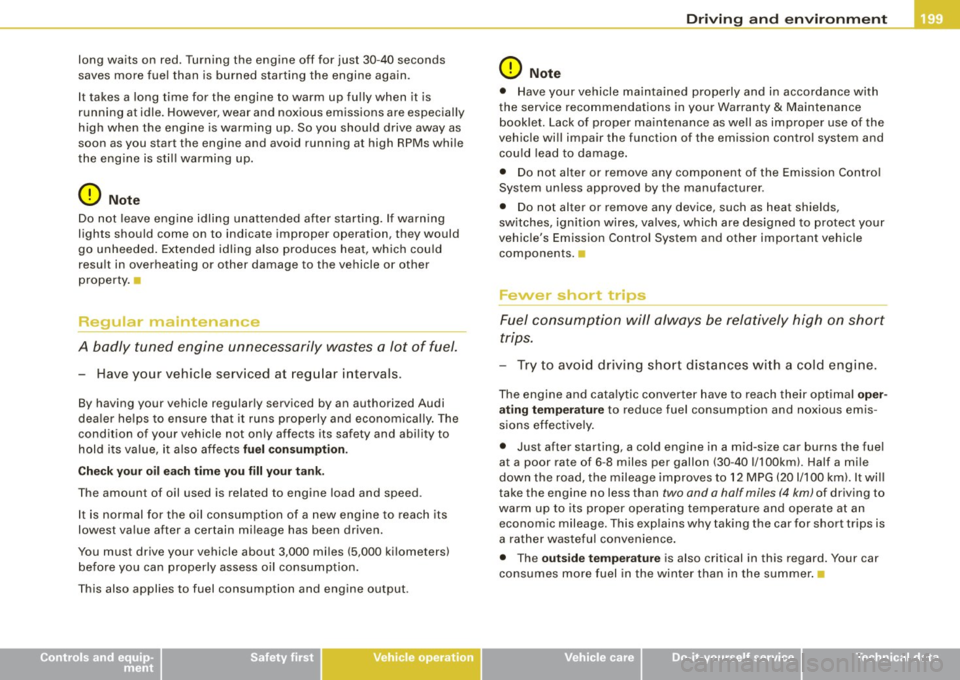
long waits on red. Turning the engine off for just 30 -40 seconds
saves more f ue l than i s bu rned star ting the engine again.
It takes a long time for the engine to warm up fully when it is
running at idle. However , wear and noxious em issions are especial ly
h ig h w hen the eng ine is warming up. So y ou should dr ive away as
soon as you start the engine and avoid running at high RPMs whi le
the eng ine is still warming up.
0 Note
Do not leave en gine idling unattended after starting. If warn ing
lights should come on to indicate improper operation, they would
go unheeded . Extended idling also produces heat, wh ich cou ld
result in overheating or other damage to the vehicle or other
property .
Regular maintenance
A badly tuned engine unnecessarily wastes a lot of fuel.
- Have your vehicle serviced at regu lar intervals.
By having your vehicle regu lar ly serviced by an authorized Audi
dea ler he lps to ensure that it runs properly and econo mically . The
condition of your vehicle not only affects its safety and abi lity to
hold i ts va lue, it a lso affects fuel consumpt ion .
Che ck yo ur oil ea ch t ime you fill your t ank.
T he amount of oil used is related to engine load and speed.
It is nor mal for the oil consumption of a new engine to reach its
lowest va lue after a certain mi leage has been driven.
You must drive your vehicle about 3,000 mi les (5,000 kilometers)
before you can proper ly assess oil consumption .
T his also applies to fuel consumption and engine output.
Controls and equip ment Safety first Vehicle operation
Dri
ving and environm ent
0 Note
• Have your vehicle maintained properly and in accordance with
the service recommendations in your Warranty
& Maintenance
booklet. Lack of proper maintenance as we ll as improper use of the
vehic le wi ll impair the function of the emission control system and
cou ld lead to damage .
• Do not alter or remove any component of the Emission Control
System unless approved by the manufacturer .
• Do not alter or remove any device, such as heat shields,
sw itches, ignition wires, valves, which are designed to protect your
vehic le's Emission Control System and other important vehicle
components. •
Fewer short trips
Fuel consump tion will always be relatively hi gh on shor t
trips.
- Try to avo id driving short dista nces wi th a cold en gine.
The engine and cata lytic c onverter have to reach their optima l oper
ating temperature to reduce fuel consumption and noxious emis
sions effective ly .
• Just after starting, a cold engine in a mid-size car burns the fuel
at a poor rate of 6 -8 miles per gallon (30 -40 11100km). Half a mi le
down the road, the mileage improves to 12 MPG (20 1/100 km). It wi ll
take the engine no less than
two and a half miles (4 km) of driving to
warm up to its proper operat ing temperature and operate at a n
economic mileage . This exp lains why taking the car for short trips is
a ra ther waste ful convenience .
• The outs ide temperat ure is also critical in this regard. Your car
consumes more fuel in the winter than in the summer .•
Vehicle care Do-it-yourself service Technical data
Page 203 of 320

Trailer lights
Trailer lights must meet all regulations. Be sure to check with your
authorized Audi dealer for correct wiring, switches and relays.
Mirrors
If you are unable to see the traffic behind you using the regular
outside mirrors, then you
must install extended mirrors. It is impor
tant that you
always have clear vision to the rear .
& WARNING
After removing the trailer hitch, do not store it in your vehicle. In
case of sudden braking, the hitch could fly forward and injure you
or your passengers .
.1
Operating instructions
Maximum trailer weight
A trailer for your vehicle is limited to a typical class 1 or class 2
trailer.
Trailer load distribution
Be sure the load in the trailer is held securely in place to guard
against shifting, be it forward, backward or sideways.
Never allow a passenger to ride in a trailer:::::, & in "Driving instruc
tions".
Tire pressure
When towing a trailer, inflate the tires of your vehicle to the cold tire
pressure listed under "Full load" on the sticker on the right door
jamb. Inflate trailer tires to trailer and tire manufacturers' specifica
tions.
Controls and equip ment Safety first Vehicle operation
Trailer towing
Lights
The
headlight settings should be checked with the trailer attached
before driving off. Adjust as necessary so that you can see the road
ahead but not blind oncoming traffic.
Check proper working of vehicle and trailer lights.
Safety chains
Be sure trailer safety chains are properly connected from the trailer
to the hitch on the vehicle. Leave enough slack in the chains to
permit turning corners. When you install safety chains, make sure
they will not drag on the road when you are driving.
The chains should cross under the trailer tongue to prevent it from
dropping in case of separation from the hitch. •
Driving instructions
Driving with a trailer always requires extra care and
consideration.
To obtain the best possible handling of vehicle and trailer,
please note the following:
Do not tow a loaded trailer when your car itself is not
loaded.
- Be especially careful when passing other vehicles.
Observe speed limits.
Do not drive at the maximum permissible speed.
- Always apply brakes early.
Monitor the temperature gauge.
Vehicle care Do-it-yourself service Technical data
Page 205 of 320
![AUDI S3 2010 Owners Guide [ i] Tips
• Do not tow a trailer during the break-in period of your vehicle.
• If you tow a trailer, your Audi may require more frequent mainte
nance due to the extr AUDI S3 2010 Owners Guide [ i] Tips
• Do not tow a trailer during the break-in period of your vehicle.
• If you tow a trailer, your Audi may require more frequent mainte
nance due to the extr](/img/6/57545/w960_57545-204.png)
[ i] Tips
• Do not tow a trailer during the break-in period of your vehicle.
• If you tow a trailer, your Audi may require more frequent mainte
nance due to the extra load=> page 299 . •
Parking on a slope
-----------------
Do not park with a trailer on a slope. If it cannot be
avoided, do so only after doing the following:
When parking:
-Apply the foot brake.
- Have someone place chocks under both the vehicle and the trailer wheels .
- With chocks in place, slowly release the brakes until
wheel blocks absorb the load.
- Turn the wheels towards the curb.
- Apply the parking brake.
- Place an automatic transmission in
P, respectively a
manual transmission in first or reverse gear.
When restarting after parking:
- Start the engine.
- Shift transmission into gear.
- Release the parking brake and slowly pull out and away from the wheel blocks.
- Stop and have someone retrieve the wheel blocks.
Controls and equip
ment Safety first Vehicle operation
Trailer towing
[
i] Tips
If you move the selector lever of the automatic transmission to P
before applying the parking brake and before blocking the wheels,
you may have to use more force later to move the lever out of the
P
position .•
Vehicle care Do-it-yourself service Technical data